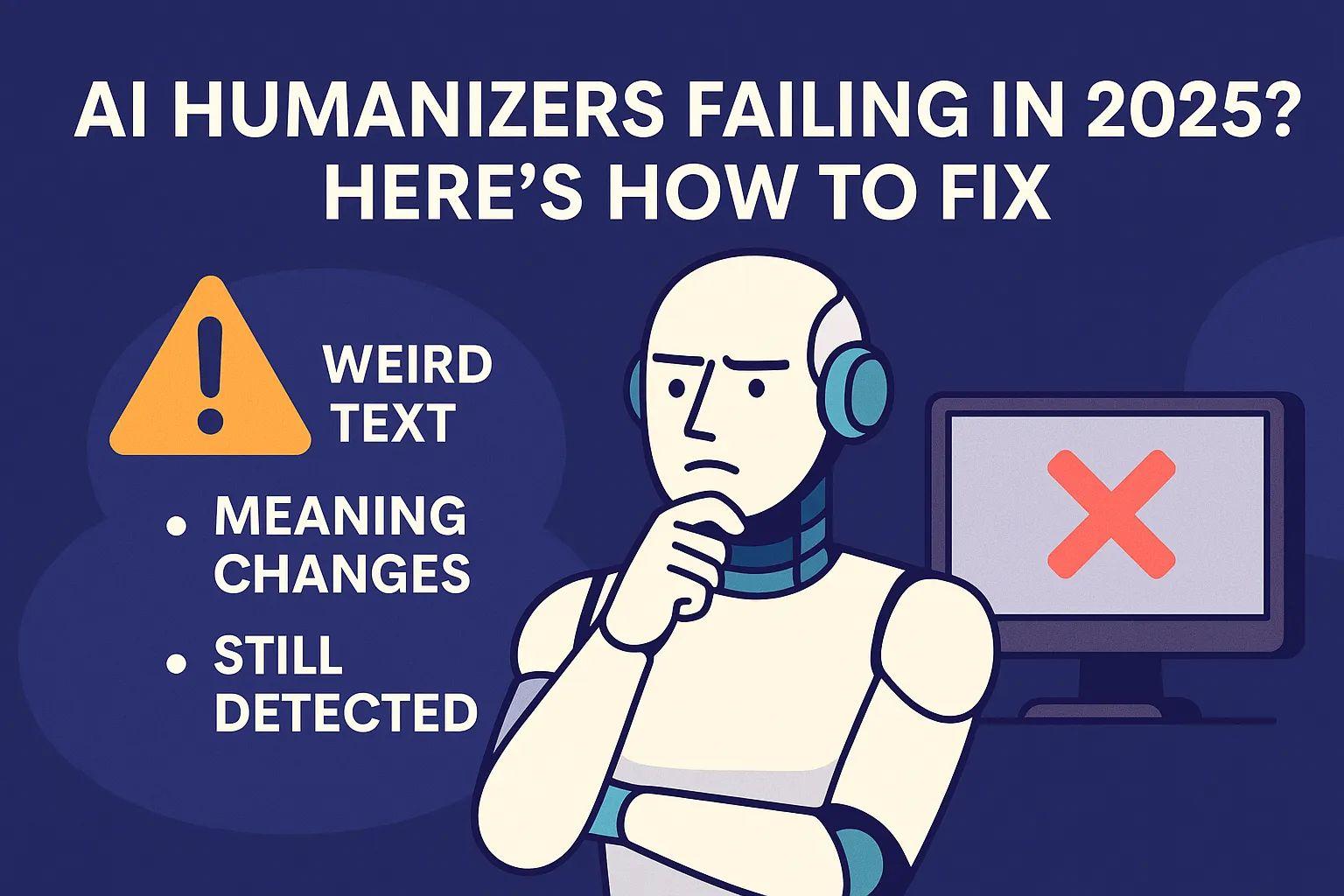AI Humanizers Failing in 2025? Here’s How to Fix
AI humanizers struggle with text quality and AI detection. Learn effective strategies to enhance natural writing and improve content authenticity.

AI Humanizers Failing in 2025? Here’s How to Fix
AI humanizers are falling short in 2025. The promise was simple: rewrite AI-generated content to make it sound more human. But what users often get is awkward, robotic language that not only changes the meaning—but still gets flagged by AI detectors like GPTZero and Originality.ai.
If you’ve used one of these tools and still got caught by detection systems, you’re not alone.
Why AI Humanizers Are Not Working
Let’s break down why most AI humanizers fail:
- Text Sounds Weird: They swap simple words for big ones, hurting flow and clarity.
- Context is Lost: Meaning gets twisted, especially in technical or nuanced writing.
- Still Detected: Tools like GPTZero use deep linguistic analysis, not just keywords or synonyms.
Modern detection models are trained to notice patterns that machines write and humans don’t. And cheap humanizing tricks just don’t cut it anymore.
Bypass GPT Detection Isn’t About Fooling—It’s About Rewriting Naturally
Forget word swaps. What works now is improving sentence flow, tone, logic, and structure—making it read like a real person wrote it. In short: human writing.
Common Problems With Today’s AI Humanizers
1. Robotic Rewriting
Swapping “help” with “facilitate” doesn’t make text sound human—it makes it sound like a machine pretending to be human.
Compare:
❌ "The application facilitates learning optimization."
✅ "This app helps you learn better."
One sounds like a press release. The other sounds like something you'd actually say.
2. Misunderstood Context
AI tools often butcher meaning by removing nuance. A sentence about climate policy can end up sounding like a vague business tip. Without context awareness, the humanizer breaks what the writer meant.
3. Weak Against Advanced AI Detectors
Tools like GPTZero and Originality.ai now spot rephrased AI text by analyzing:
- Sentence rhythm
- Word complexity
- Style patterns
- Predictability
This means even lightly rewritten content can still get flagged unless real thought is put into editing.
What Makes AI Writing Easy to Detect
Even after humanizing, AI content can still get flagged—why?
Modern AI detectors like GPTZero and Originality.ai don’t just look for repeated words or overused phrases. They use advanced linguistic analysis that focuses on how humans write vs how machines generate text.
Here’s what usually gives AI away:
- Uniform sentence structure: AI often creates sentences that are grammatically perfect but rhythmically repetitive.
- Lack of randomness: Human writing has quirks—AI doesn’t. Real people mix things up, use unexpected phrases, or shift tone mid-paragraph.
- No personal insight: AI content rarely includes personal stories, specific emotions, or lived experiences.
- Predictable transitions: Machines tend to rely on safe words like “in conclusion” or “moreover,” creating an obvious rhythm.
These subtle cues make it easier for AI detectors to classify content, even if it’s been rewritten. That’s why tools that just “spin” content or change synonyms usually don’t work anymore.
Want to learn more? See our post on how AI humanizers compare to detectors.
How to Fix AI Humanizers (And Actually Bypass Detection)
Let’s talk about practical ways to write or edit AI content so it sounds human and passes AI checks.
1. Use Smarter Prompts (If You’re Using AI)
AI gives better output when you guide it better. For example:
❌ “Write about AI detectors.”
✅ “Explain how AI detectors work, and why students and writers should care, with real-world examples.”
Want more help? See our guide to humanizing ChatGPT content.
2. Rewrite With a Real Voice
Whether editing by hand or using a tool, focus on:
- Varying sentence length
- Adding personal tone
- Using simpler words
- Avoiding jargon
Also, use contractions like “you’ll” or “don’t”—real people do that all the time.
3. Add Real Examples or Insights
Want to fool AI detectors? Add the one thing they can’t replicate: lived experience.
Examples:
- “In my marketing job, I used Grammarly and noticed...”
- “One thing students often forget about GPTZero is...”
Human content has real emotion, memory, and reaction. Drop in short, real-world insights and your content immediately feels different.
4. Test and Refine With Detectors
Before publishing, check your content with real tools.
| Tool | Key Features |
|---|---|
| GPTZero | Sentence-level detection, clear reports |
| Originality.ai | Chrome extension, low false positives |
Don’t just rely on the score. If a few lines are flagged, focus your edits there.
You can also try tools with a rewriting + detection combo to speed things up.
How Human Editors Still Win
Many creators are now going back to basics: using AI to generate ideas or drafts, then editing by hand. Here's why it works:
| Step | What It Adds |
|---|---|
| AI Draft | Speed, structure |
| Human Rewrite | Emotion, tone, flow |
| Detection Test | Final polish & trust |
This approach feels more natural and gets better results—both for humans and machines.
Should You Even Use AI Humanizers in 2025?
If basic tools fail, is it still worth trying to humanize AI content?
Yes—if you do it right.
In 2025, AI humanizers have evolved. But success doesn’t come from just running text through a tool and hoping for the best. You need a layered approach:
- AI → Humanizer → Manual Edit → Detection Test
Used properly, a good AI humanizer saves time while improving structure and tone. But you still need human input for natural flow and meaning.
That’s why the best content creators don’t just automate—they collaborate with AI.
Whether you're a student, writer, or developer, choosing the right tool matters. For example, developers often use humanizer APIs to integrate rewriting features directly into their platforms, allowing more control over tone and logic.
In short: Yes, use humanizers—but only with human oversight. Otherwise, you risk ending up with robotic, detectable content that hurts your trust and rankings.
Quick Fix Tips for Better AI Rewrites
Here’s a checklist to humanize your AI content:
✅ Short & long sentence mix
✅ Use personal language (“I”, “you”, “we”)
✅ Replace stiff phrases
✅ Add examples
✅ Cut jargon
✅ Read aloud—does it sound like a person?
Final Thoughts: Don’t Just Trick—Write Better
If you're serious about making AI-written content sound human, don’t rely on shortcuts. Real human input matters more than ever. Focus on clarity, flow, tone, and truth. Test often, and improve over time.
Detection tools will keep evolving. But if your content sounds natural, adds value, and reflects real thinking, you’ll always stay ahead.
FAQs
What’s the main reason AI humanizers fail in 2025?
Most still rely on simple paraphrasing that doesn’t fool modern AI detectors. They miss tone, flow, and context.
Can you bypass GPTZero or Originality.ai?
Yes, if your content is rewritten with natural language, added examples, and better flow. Tools like GPTZero detect robotic patterns—not well-written human content.
Are there tools that help humanize and check at the same time?
Yes, platforms like HumanizerPro combine rewriting with detection, letting you preview AI vs human scores before you publish.

Kamran Khan
Kamran Khan is the founder of AI Humanizer PRO and a leading voice in the ethical use of AI-generated content. With years of hands-on experience in AI, SEO, and digital publishing, he built HumanizerPro to help creators and professionals turn robotic AI text into clear, human-like writing that meets real-world standards.